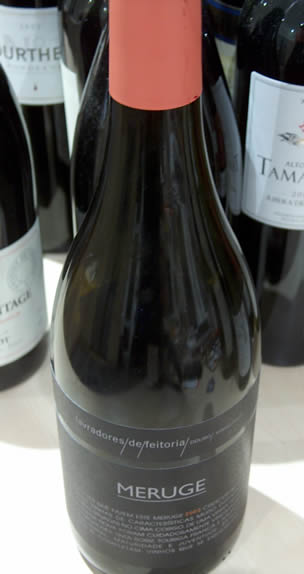|
Extended
tasting note 9
Lavradores
de Feitoria Meruge
2003 Douro
 Douro
wines are beginning to establish themselves as Iberiaís best. This
is a controversial statement: letís face it, Portuguese wines still
play second fiddle to those of Spain. The Spanish regions of Rioja,
Ribero del Duero and Priorat all boast icon wines that sell for
enormous sums. Am I therefore mad to suggest that the Douro has more
potential than all these three classic regions, and that it is
beginning to realize it? You might think so, but let me put my case. Douro
wines are beginning to establish themselves as Iberiaís best. This
is a controversial statement: letís face it, Portuguese wines still
play second fiddle to those of Spain. The Spanish regions of Rioja,
Ribero del Duero and Priorat all boast icon wines that sell for
enormous sums. Am I therefore mad to suggest that the Douro has more
potential than all these three classic regions, and that it is
beginning to realize it? You might think so, but let me put my case.
Look at the terroirs of the Douro. Fantastic schistous
soils, with any variety of slopes, altitudes, aspects and orientations
possible because of the Douro river and its snaking tributaries, with
towering banks on either side, flattening out somewhat towards the
Spanish border.
Then look at the grape varieties. Spain has Tempranillo,
Garnacha and Carignena in its premium regions, with bit part roles for
the likes of Graciano and Cabernet Sauvignon. The Douro has Touriga
Nacional, Tinta Roriz (Tempranillo), Touriga Franca, Sous„o, Tinta C„o,
Tinta Barocca, Tinta Amarela and many others.
But then consider the scale: the Douro is huge. Amazing
untapped potential, compounded by the fact that currently a lot of the
good grapes go into Port. As the table wine revolution here gathers
steam, the quality of the new wines emerging is fantastic.
So we come to tonightís wine. Meruge 2003 from
Lavradores de Feitoria. This producer is an association of 15 quintas,
and this is one of their top wines. The shape of the
bottleóBurgundyógives something away. This is a wine thatís made
in a more Burgundian style, meaning that the emphasis is on elegance
rather than structure. As you might expect, Dirk Niepoort is behind
this wine.
Itís quite dark coloured. Deep red/purple/black in
colour. The nose is very inviting. Itís ripe, deep and smooth,
showing a subtly chocolatey edge to the red berry fruit. Thereís
some freshness and spiciness, too. The overall impression is one of
elegance coupled with concentration. The palate is smooth and elegant
with a good concentration of sweet red fruits. Thereís a lovely
structure here: some spicy tannin, a hint of greenness under the sweet
fruit, and good acid. The overall impression is one of a serious,
classy, complete wine. Itís certainly not Burgundyóthe fruit is
too ripe for thisóbut thereís a delicious elegance here that is
more Burgundy than it is Bordeaux. Thereís a suggestion of
modern-ness, with the slightly roasted, chocolatey notes hiding
beneath the ripe fruit, but itís not a distraction from the main
theme of the wine. Besides, in a young wine like this where the stems
have been included (half the wine was made with stems), itís easy to
confuse the stem imprint with oakiness.
Overall, I think this is an interesting, complex,
elegant wine that may well develop very positively over the next few
years. Itís serious, to the point that even on this early showing
Iíd score it at 93/100, and a fantastic ambassador for the new fine
wines of the Douro, particularly because with its somewhat Burgundian
profile it offers a glimpse of another side of what the Douro is
capable of.
The label design is fantastic. I have no idea what this
wine would retail for in the UK, but my suspicion is that it would be
around £20. Raymond Reynolds represent the Feitoria wines in the UK.
Drinking window? Itís lovely now, but best in 5Ė15 years time, I
guess.
Other
ETNs:
GrŁnhaus;
Roc des Anges; Gaillard;
Veratina; Arturo;
Wynns; Drystone;
Foundry and Columella; Meruge;
Foillard Morgon; Clonakilla
tasted
10/05
Back to top
|

